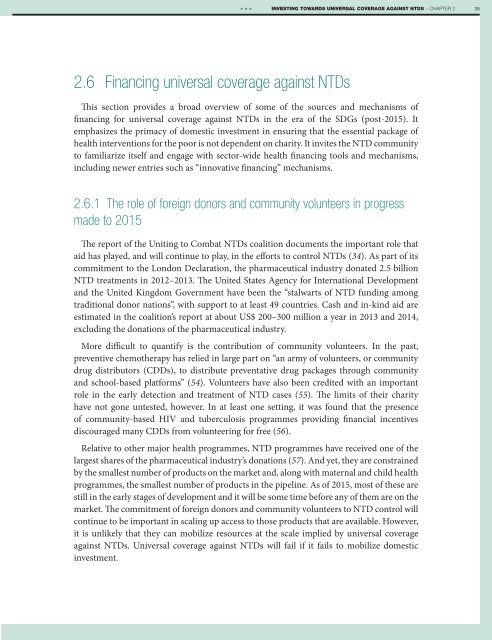1A9bnbK
1A9bnbK
1A9bnbK
Create successful ePaper yourself
Turn your PDF publications into a flip-book with our unique Google optimized e-Paper software.
***<br />
INVESTING TOWARDS UNIVERSAL COVERAGE AGAINST NTDS − CHAPTER 2<br />
35<br />
2.6 Financing universal coverage against NTDs<br />
This section provides a broad overview of some of the sources and mechanisms of<br />
financing for universal coverage against NTDs in the era of the SDGs (post-2015). It<br />
emphasizes the primacy of domestic investment in ensuring that the essential package of<br />
health interventions for the poor is not dependent on charity. It invites the NTD community<br />
to familiarize itself and engage with sector-wide health financing tools and mechanisms,<br />
including newer entries such as “innovative financing” mechanisms.<br />
2.6.1 The role of foreign donors and community volunteers in progress<br />
made to 2015<br />
The report of the Uniting to Combat NTDs coalition documents the important role that<br />
aid has played, and will continue to play, in the efforts to control NTDs (34). As part of its<br />
commitment to the London Declaration, the pharmaceutical industry donated 2.5 billion<br />
NTD treatments in 2012–2013. The United States Agency for International Development<br />
and the United Kingdom Government have been the “stalwarts of NTD funding among<br />
traditional donor nations”, with support to at least 49 countries. Cash and in-kind aid are<br />
estimated in the coalition’s report at about US$ 200–300 million a year in 2013 and 2014,<br />
excluding the donations of the pharmaceutical industry.<br />
More difficult to quantify is the contribution of community volunteers. In the past,<br />
preventive chemotherapy has relied in large part on “an army of volunteers, or community<br />
drug distributors (CDDs), to distribute preventative drug packages through community<br />
and school-based platforms” (54). Volunteers have also been credited with an important<br />
role in the early detection and treatment of NTD cases (55). The limits of their charity<br />
have not gone untested, however. In at least one setting, it was found that the presence<br />
of community-based HIV and tuberculosis programmes providing financial incentives<br />
discouraged many CDDs from volunteering for free (56).<br />
Relative to other major health programmes, NTD programmes have received one of the<br />
largest shares of the pharmaceutical industry’s donations (57). And yet, they are constrained<br />
by the smallest number of products on the market and, along with maternal and child health<br />
programmes, the smallest number of products in the pipeline. As of 2015, most of these are<br />
still in the early stages of development and it will be some time before any of them are on the<br />
market. The commitment of foreign donors and community volunteers to NTD control will<br />
continue to be important in scaling up access to those products that are available. However,<br />
it is unlikely that they can mobilize resources at the scale implied by universal coverage<br />
against NTDs. Universal coverage against NTDs will fail if it fails to mobilize domestic<br />
investment.


